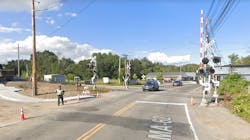MBTA, Keolis adding safety protocols to mitigate human error-related risks at Wilmington crossing
A North Wilmington, Mass., grade-crossing will see added safety protocols put into place at a crossing where a 68-year-old woman died in January 2022 when her car and a Massachusetts Bay Transportation Authority (MBTA) commuter train collided.
Investigators did not find defects or other problems with the crossing system. According to MBTA, a signal maintainer for its commuter rail contractor, Keolis, performed regularly scheduled testing and preventative maintenance of the crossing’s safety system. MBTA’s preliminary finding determined the safety system was not returned to its normal operating mode, which resulted the crossing gates not coming down in a timely manner as the train approached Middlesex Avenue.
The town of Wilmington reported anomalies at the same crossing on Feb. 18, which MBTA determined to be the result of melting snow mixed with road salt that created a short-term ponding condition. This condition triggered crossing system sensors resulting in the crossing arms being lowered. MBTA said trains stopped before the crossing and slowly rolled through, allowing the crossing arms to deploy as intended.
MBTA and Keolis Commuter Services say they “are focused on the human element of federally mandated railroad crossing testing.” They say multiple tests have confirmed all elements of the crossing’s infrastructure have continued to perform as designed and they will take additional steps to enhance protocols for testing the crossing’s protection system.
“I’d like to assure the community that the protection system at the Middlesex Avenue railroad crossing is safe and fully operational,” said MBTA General Manager Steve Poftak. “On top of our regular maintenance, inspection and testing procedures, additional rules and instructions for commuter rail personnel have been introduced to provide another layer of safety-related enhancements.”
The added measures MBTA and Keolis have initiated include:
- After the testing is completed, the commuter rail dispatchers must request and receive affirmation from the signal maintainer that the protection system is enabled.
- Following the step mentioned previously, the signal maintainer must remain on-site until the next train passes to ensure the crossing’s protection system is fully operational and, if necessary, be prepared to manually control the protection system if the system does not perform as expected.
- New signage will be installed on the inside of each signal bungalow door to serve as a visual reminder to Keolis personnel to ensure that the crossing equipment has been fully and properly returned to service.
Keolis notes it has completed a retraining of its signal maintainers on the procedures that must be followed before, during and after the process of performing regular testing of the railroad crossing’s protection system.
Keolis Boston CEO and General Manager Abdellah Chajai committed to working with the MBTA and the Keolis crews to ensure safe operations throughout the network and at the Middlesex crossing.
“Safety for our people, our passengers and the communities that depend on commuter rail service is our first priority at Keolis,” said Chajai.

Mischa Wanek-Libman | Group Editorial Director
Mischa Wanek-Libman is director of communications with Transdev North America. She has more than 20 years of experience working in the transportation industry covering construction projects, engineering challenges, transit and rail operations and best practices.
Wanek-Libman has held top editorial positions at freight rail and public transportation business-to-business publications including as editor-in-chief and editorial director of Mass Transit from 2018-2024. She has been recognized for editorial excellence through her individual work, as well as for collaborative content.
She is an active member of the American Public Transportation Association's Marketing and Communications Committee and served 14 years as a Board Observer on the National Railroad Construction and Maintenance Association (NRC) Board of Directors.
She is a graduate of Drake University in Des Moines, Iowa, where she earned a Bachelor of Arts degree in Journalism and Mass Communication.


